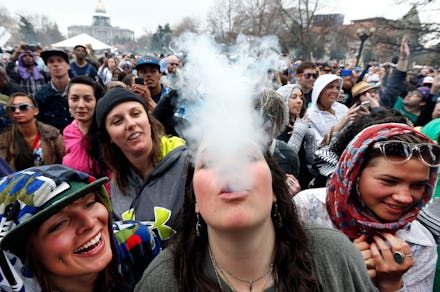One Chart Shows the War on Drugs Is Hitting a Disturbing New Low

The results are in and they're not looking good. The FBI released its Uniform Crime Report for 2014 on Monday, revealing nearly 40% of drug-related arrests were for marijuana possession alone. Not for cooking meth in your bathtub. Not for manufacturing or selling marijuana — just for carrying some.
The estimated number of arrests for 2014 was 11,205,833, with nearly 14% or that — or 1,561,231 arrests — accounting for drug abuse violations. The following, therefore, is a rough estimate and comparison of the number of drug-related arrests since 2009. Though overall arrests are trending down, the proportion of drug-related arrests has been steadily rising.
What's more, nearly 620,000 arrests were made for marijuana possession, which equals around 40% of drug-related arrests. In other words, that's an average of around 1,700 arrests per day over the course of the year. Only roughly 5% of all drug arrests were for marijuana sale or manufacturing.
In total, more than 80% of drug arrests were for possession and, among all the different classifications of drug abuse violations, possession of marijuana accounts for by far the highest proportion. Possession of "other dangerous nonnarcotic drugs" trails behind at 21.5%, with almost half the number marijuana possession arrests.
The FBI Uniform Crime Reports data is self-reported by participating law enforcement agencies from every level, from universities to state and federal. Ultimately, the report offers more of a guideline than precision and there were likely many more drug-related (marijuana included) arrests in 2014 than are represented in the data, Vocativ notes.
The complexity of crime statistics and the absence of complete data make it hard to create definitive annual comparisons. "These rough rankings provide no insight into the numerous variables that mold crime in a particular town, city, county, state or region," the FBI warns of the Uniform Crime Report.
All this, despite the legalization of cannabis in many states. In almost half of all states, marijuana is legal in some capacity, whether medical or recreational, like in Oregon, Washington, Alaska, Colorado and Washington, DC.
Advocates fighting cannabis prohibition seem to have momentum on their side, and it is likely more states will soon follow. "We believe cannabis is a mainstream product consumed by mainstream people," Zack Hutson, public relations director at Privateer Holdings, the private equity firm invested in Bob Marley's cannabis brand, told Mic in June.
Yet the numbers of weed-related arrests are still very high. The war on drugs costs the United States more than $51 billion annually, according to the Drug Policy Alliance. Legalizing drugs, on the other hand, would generate more than an estimated $46 billion in revenue for the government, the Cato Institute reports in a paper on the benefits of drug legalization.
"Legalization would reduce state and federal deficits by eliminating expenditure on prohibition enforcement — arrests, prosecutions and incarceration — and by allowing governments to collect tax revenue on legalized sales," the Cato Institute writes.
Despite the astronomical drain on American resources, the supposed "war on drug" wages. To put the price of this war in perspective, the government spends around $30,000 a year on an inmate and less than $12,000 a year on a public school student.